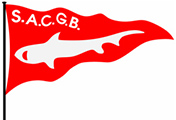Tagging
The earliest mention of tagging within the Shark Angling Club of Great Britain was recorded in the minutes of a committee meeting on the 6th June 1959 when Brigadier J A L Caunter presented a proposal made to the club via him by the Ministry of Agriculture and Fisheries. Since then the club have been active partners in a number of tagging schemes. Sharks over a certain size, generally those above an estimated weight of 50lbs, are suitable for tag and release.
Each tag has a number and the tag record card records when and where the shark was caught, its measurements, sex and general condition.
In the event the shark is re-captured, the tag is then returned with the new information, which enables marine scientists to establish how far the shark has traveled, over what period, and how much it has changed in size.
In 2015, the SACGB became a partner with a shark tagging scheme called the NMFS – Apex Predators Co-operative Shark Tagging Programme, who are affiliated to the National Oceanic and Atmospheric Administration organisation in the USA.
This tagging programme has been running since 1962. In the period to 2015, over 243,000 sharks of 52 species have been tagged and more than 14,000 sharks of 33 species have been recaptured.
To find out more about this programme, please visit their webpage.
